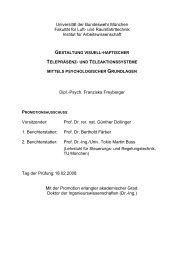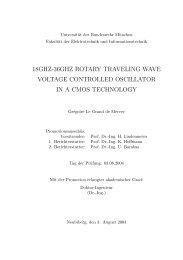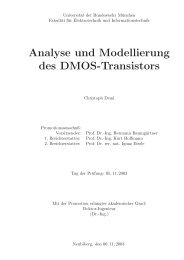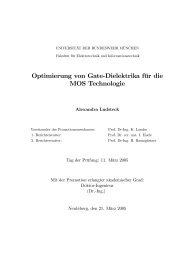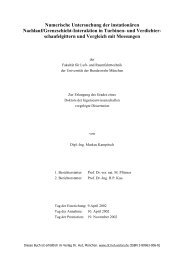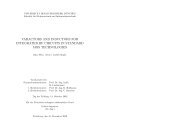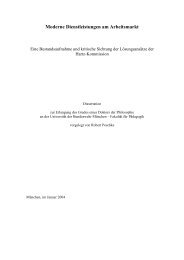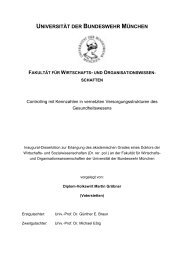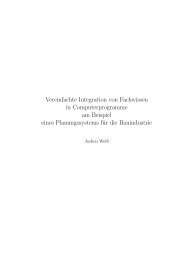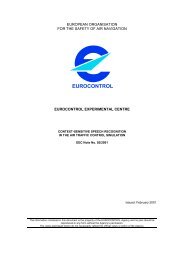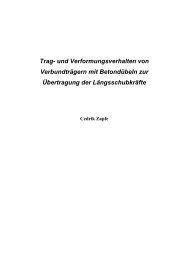Precise Orbit Determination of Global Navigation Satellite System of ...
Precise Orbit Determination of Global Navigation Satellite System of ...
Precise Orbit Determination of Global Navigation Satellite System of ...
Create successful ePaper yourself
Turn your PDF publications into a flip-book with our unique Google optimized e-Paper software.
Chapter 4 Major Error Sources <strong>of</strong> <strong>Satellite</strong> Observations<br />
Shorter wavelength radio signals pass through the ionosphere but are affected by it. These shorter wavelengths<br />
are used by satellites for communication and navigation purpose, and the ionosphere affects the signals rather<br />
like the way the atmosphere causes "twinkling" <strong>of</strong> the stars.<br />
Considerable efforts have, therefore, been concentrated on modeling this ionospheric parameter. Several models<br />
are available including the Chiu model (Chiu, 1975), the Bent model (Bent et al. 1972) that has been used<br />
extensively for satellite tracking, the semi-empirical SLIM model (Anderson et al, 1987) based on theoretically<br />
obtained grid values, and the FAIM model (Anderson et al, 1989) that uses the Chiu formalism together with the<br />
SLIM results. The International Reference Ionosphere (IRI) is probably the most mature <strong>of</strong> these models, having<br />
undergone more than two decades <strong>of</strong> scrutiny and improvement.<br />
At present, almost all empirical models <strong>of</strong> ionospheric parameters are limited to non-auroral, magnetically quiet<br />
conditions. Major efforts are underway to extend ionospheric predictability beyond these limitations. A<br />
promising venue seems to be the inclusion <strong>of</strong> real-time data from the newly developed automatical recording and<br />
scaling ionosondes.<br />
Following H<strong>of</strong>mann-Wellenh<strong>of</strong> (1992), Klobuchar (1996), Seeber (1993) and Wild (1994), the phase and range<br />
refractive indices can be written as<br />
a<br />
n p = 1+<br />
(4-10)<br />
2<br />
f<br />
n r<br />
a<br />
= 1−<br />
(4-11)<br />
2<br />
f<br />
Then first orders <strong>of</strong> ionospheric group and phase delays for range and phase observations are proportional to the<br />
integrated number <strong>of</strong> free electrons along the propagation path and inversely proportional to the square <strong>of</strong><br />
transmission frequency and can be written as<br />
∆S = � Ndl<br />
f<br />
ion 40.<br />
3<br />
p 2<br />
34<br />
(4-12)<br />
∆S = − � Ndl<br />
f<br />
ion 40.<br />
3<br />
r (4-13)<br />
2<br />
where f is the carrier frequency and � Ndl is Total Electron Content (TEC), integrated along the path from<br />
ground tracking station to satellite.<br />
From Eq.(4-12) and Eq.(4-13) it can be seen that changes <strong>of</strong> range and phase caused by the ionospheric<br />
refraction may be restricted to the determination <strong>of</strong> the total electron content (TEC). TEC itself is dependent on<br />
sunspot activities, seasonal and diurnal variations, the line <strong>of</strong> sight which includes elevation and azimuth <strong>of</strong> the<br />
satellite and the position <strong>of</strong> the observation site.<br />
Usually TEC can be measured using dual frequency observations forming wide-lane linear combination (L4). In<br />
the case <strong>of</strong> code observations the total electron content is proportional to the difference <strong>of</strong> the ionospheric<br />
refraction on the two frequencies. Ionospheric error can also be removed by ionosphere-free linear combination<br />
(L3). For single frequency users, some mathematical models, for examples, Klobuchar model (Klobuchar, 1996)<br />
and single-layer model (Wild 1994) may be used.<br />
Following Wild (1994), a simple and widely used mathematic model, single-layer model (SLM) will be<br />
discussed here.<br />
SLM is based on the assumption that all free electrons are concentrated in a spherical layer <strong>of</strong> infinitesimal<br />
thickness (single layer) at a height H above the earth’s surface. From Eq.(4-12) and Eq.(4-13), ionospheric<br />
correction can be written as<br />
TVEC<br />
S<br />
f z<br />
ion 40.<br />
3<br />
∆ = ±<br />
2 cos ′<br />
where<br />
z′ zenith distance at the intersection P <strong>of</strong> the actual signal with the single-layer<br />
(4-14)



